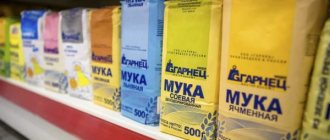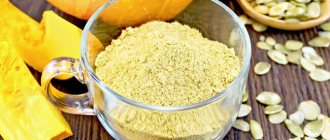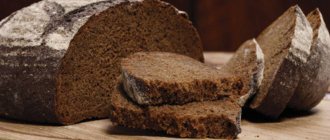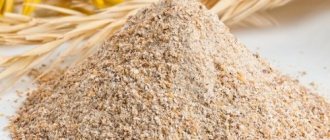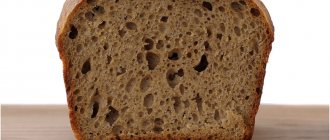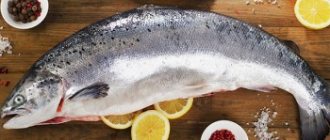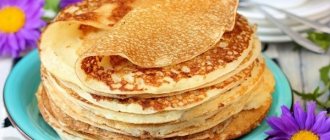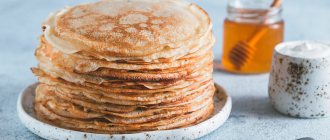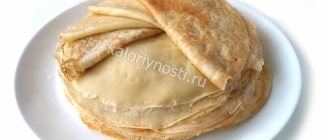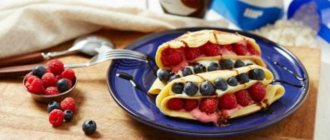Types of rye flour
The type of flour is selected depending on the type of baked goods being prepared. Several types of substances are used, the properties, benefits and harms of which differ:
| Type of flour | Properties | Notes |
| Peklevannaya | Very fine grinding, used for gingerbread, light cream bread, and pies. | Due to intensive processing, the composition contains few vitamins and other valuable substances. |
| Seeded | Used in its pure form, without impurities, it makes good homemade baked goods. | Low calorie content, products are recommended for diabetics and during diets. |
| Ripped off | Low nutritional value and gluten content, only for bread. | When making homemade bread, you need to include some wheat flour among the ingredients. |
| Wallpaper | Very coarse grinding, the characteristics of unprocessed cereals are fully preserved. | In terms of benefits it surpasses buckwheat and barley flour. |
We recommend reading: What are the benefits of yeast-free bread and how to bake it
The properties of wallpaper flour make it an excellent way to combat constipation, atherosclerosis, and high cholesterol without medications. The benefits of raw materials lie not only in their rich composition, but also in the abundance of fiber. Peeled rye flour is beneficial for weakened hair.
Varieties of rye flour
Rye flour can be milled in different ways, depending on the variety. The number of bran particles included in the composition of rye flour also varies. In the food industry, the following types are distinguished:
- peklevanny
– the finest type of grinding. This type is carefully sifted and does not contain bran particles. It is used for baking rye bread without additives, as well as gingerbread cookies, pies and other confectionery delights. But, despite the taste, fineness of grinding and soft creamy appearance, this variety contains practically no vitamins. - seeded
- this type is not too different from peked. It is most often used without admixtures from other types of flour. The color of this flour is white, with a creamy or bluish tint. Dishes prepared with sifted rye flour are low in calories. There is more dietary fiber in this flour than in wheat flour. - peeled rye flour
. After grinding, the yield is 90%. It is in second place in terms of nutritional value and low gluten content. Because of this, the use of peeled flour is limited to baking bread, regular and custard varieties. At home, for baking, peeled rye flour should be mixed with wheat flour. Otherwise the dough will not be elastic. The taste and aroma of homemade bread from this variety is wonderful, and the bread itself is very healthy. - wallpaper
_ This type of flour is the coarsest type of grinding. It is obtained from rye grains that have not been pre-cleaned. The color of wallpaper flour is dark gray. This type of rye flour retains 100% of the components from the grain, and it also contains the highest percentage of bran particles. This variety is used together with wheat flour to bake table breads. It is rye wallpaper flour that contains three times more minerals and vitamins than wheat flour. And the fiber content is higher than that of buckwheat and barley.
Products made from wallpaper flour are the most beneficial for the human body. They help protect against constipation, high cholesterol and atherosclerosis. No matter how dense and rough such products may be, the abundance of fiber in them ensures the normalization of the digestive tract.
Chemical composition of rye flour
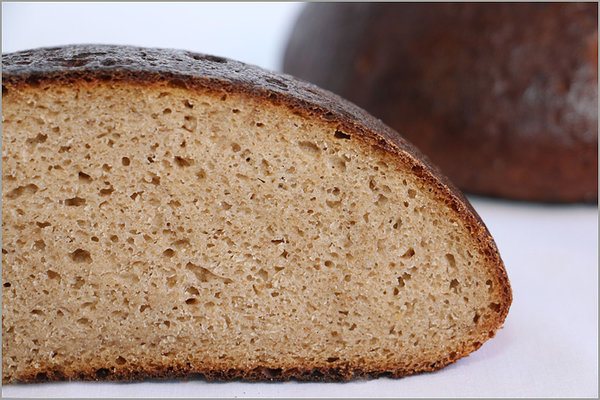
The beneficial composition of the raw materials provides the body with the following minerals:
- Phosphorus – maintains healthy cartilage and bones.
- Magnesium, iron - help the body in normal hematopoiesis.
- Potassium – timely transmission of nerve impulses.
- Calcium – high-quality activity of the nervous system, strong skeleton.
The raw materials are rich in macro- and microelements, vitamins B and E, useful for the cardiovascular system, the thyroid gland, and the treatment of anemia. It does not cause harm, it only guarantees good health.
Rye flour: calorie content per 100 grams, vitamins, nutritional value
The total calorie content of rye flour per 100 grams is 296 kcal, including 100 g of product contains:
- proteins – 8.7 g (37 kcal);
- fat – 1.8 g (16 kcal);
- carbohydrates – 62 g (243 kcal).
The vitamin and mineral composition of rye flour in 100 g of product is represented by the following vitamins and minerals (the percentage of the substance from the daily value for a healthy adult is indicated in parentheses):
- B1 (28%);
- B2 (8.3%);
- B6 (18%);
- B9 (14%);
- E (15%);
- RR (17%);
- potassium (16%);
- magnesium (19%);
- phosphorus (32%);
- iron (23%);
- manganese (130%);
- copper (35%);
- molybdenum (15%);
- chromium (8.6%);
- zinc (16%).
Nutritional value and calorie content of rye flour
A standard 100 g contains carbohydrates (61.8 g), proteins (8.9 g) and fats (1.7 g). Total calorie content from 298 kcal to 305 kcal. This is less than that of a wheat product, so it is rye flour that will benefit weight loss.
We recommend reading: What are the benefits of wheat bran, reviews
The energy value depends on the growing conditions, the type of planting material and the degree of processing. A good percentage of useful components allows us to classify products, especially those made from wholemeal flour, as dietary food.
Advice! When preparing homemade rye kvass, you can infuse it exclusively in glass containers. This will prevent harmful impurities from getting into the drink.
We recommend reading: Homemade kvass: benefits and harms
Calorie content Rye flour. Chemical composition and nutritional value.
Nutritional value and chemical composition of “Rye flour”.
The table shows the nutritional content (calories, proteins, fats, carbohydrates, vitamins and minerals) per 100 grams of edible portion.
| Nutrient | Quantity | Norm** | % of the norm in 100 g | % of the norm in 100 kcal | 100% normal |
| Calorie content | 306 kcal | 1684 kcal | 18.2% | 5.9% | 550 g |
| Squirrels | 9 g | 76 g | 11.8% | 3.9% | 844 g |
| Fats | 2 g | 56 g | 3.6% | 1.2% | 2800 g |
| Carbohydrates | 63 g | 219 g | 28.8% | 9.4% | 348 g |
| Alimentary fiber | 12.4 g | 20 g | 62% | 20.3% | 161 g |
| Water | 14 g | 2273 g | 0.6% | 0.2% | 16236 g |
| Ash | 1.2 g | ~ | |||
| Vitamins | |||||
| Vitamin B1, thiamine | 0.35 mg | 1.5 mg | 23.3% | 7.6% | 429 g |
| Vitamin B2, riboflavin | 0.13 mg | 1.8 mg | 7.2% | 2.4% | 1385 g |
| Vitamin B4, choline | 20.6 mg | 500 mg | 4.1% | 1.3% | 2427 g |
| Vitamin B5, pantothenic | 0.492 mg | 5 mg | 9.8% | 3.2% | 1016 g |
| Vitamin B6, pyridoxine | 0.25 mg | 2 mg | 12.5% | 4.1% | 800 g |
| Vitamin B9, folates | 50 mcg | 400 mcg | 12.5% | 4.1% | 800 g |
| Vitamin E, alpha tocopherol, TE | 1.9 mg | 15 mg | 12.7% | 4.2% | 789 g |
| Vitamin H, biotin | 3 mcg | 50 mcg | 6% | 2% | 1667 g |
| Vitamin K, phylloquinone | 5.9 mcg | 120 mcg | 4.9% | 1.6% | 2034 |
| Vitamin RR, NE | 2.8 mg | 20 mg | 14% | 4.6% | 714 g |
| Niacin | 1 mg | ~ | |||
| Macronutrients | |||||
| Potassium, K | 350 mg | 2500 mg | 14% | 4.6% | 714 g |
| Calcium, Ca | 34 mg | 1000 mg | 3.4% | 1.1% | 2941 g |
| Magnesium, Mg | 60 mg | 400 mg | 15% | 4.9% | 667 g |
| Sodium, Na | 2 mg | 1300 mg | 0.2% | 0.1% | 65000 g |
| Sera, S | 68 mg | 1000 mg | 6.8% | 2.2% | 1471 g |
| Phosphorus, P | 189 mg | 800 mg | 23.6% | 7.7% | 423 g |
| Microelements | |||||
| Aluminium, Al | 270 mcg | ~ | |||
| Iron, Fe | 3.5 mg | 18 mg | 19.4% | 6.3% | 514 g |
| Yod, I | 3.9 mcg | 150 mcg | 2.6% | 0.8% | 3846 g |
| Manganese, Mn | 1.34 mg | 2 mg | 67% | 21.9% | 149 g |
| Copper, Cu | 230 mcg | 1000 mcg | 23% | 7.5% | 435 g |
| Molybdenum, Mo | 6.4 mcg | 70 mcg | 9.1% | 3% | 1094 g |
| Selenium, Se | 14.4 mcg | 55 mcg | 26.2% | 8.6% | 382 g |
| Fluorine, F | 38 mcg | 4000 mcg | 1% | 0.3% | 10526 g |
| Zinc, Zn | 1.23 mg | 12 mg | 10.3% | 3.4% | 976 g |
| Digestible carbohydrates | |||||
| Starch and dextrins | 60.7 g | ~ | |||
| Mono- and disaccharides (sugars) | 0.9 g | max 100 g | |||
| Essential amino acids | |||||
| Arginine* | 0.42 g | ~ | |||
| Valin | 0.51 g | ~ | |||
| Histidine* | 0.19 g | ~ | |||
| Isoleucine | 0.38 g | ~ | |||
| Leucine | 0.58 g | ~ | |||
| Lysine | 0.3 g | ~ | |||
| Methionine | 0.12 g | ~ | |||
| Methionine + Cysteine | 0.27 g | ~ | |||
| Threonine | 0.26 g | ~ | |||
| Tryptophan | 0.11 g | ~ | |||
| Phenylalanine | 0.5 g | ~ | |||
| Phenylalanine+Tyrosine | 0.76 g | ~ | |||
| Nonessential amino acids | |||||
| Alanin | 0.42 g | ~ | |||
| Aspartic acid | 0.69 g | ~ | |||
| Glycine | 0.45 g | ~ | |||
| Glutamic acid | 1.97 g | ~ | |||
| Proline | 0.56 g | ~ | |||
| Serin | 0.42 g | ~ | |||
| Tyrosine | 0.26 g | ~ | |||
| Cysteine | 0.15 g | ~ | |||
| Saturated fatty acids | |||||
| Saturated fatty acids | 0.2 g | max 18.7 g | |||
| 16:0 Palmitinaya | 0.16 g | ~ | |||
| 18:0 Stearic | 0.01 g | ~ | |||
| 20:0 Arakhinovaya | 0.01 g | ~ | |||
| Monounsaturated fatty acids | 0.16 g | min 16.8 g | 1% | 0.3% | |
| 16:1 Palmitoleic | 0.01 g | ~ | |||
| 18:1 Oleic (omega-9) | 0.15 g | ~ | |||
| Polyunsaturated fatty acids | 0.84 g | from 11.2 to 20.6 g | 7.5% | 2.5% | |
| 18:2 Linolevaya | 0.74 g | ~ | |||
| 18:3 Linolenic | 0.1 g | ~ | |||
| Omega-3 fatty acids | 0.1 g | from 0.9 to 3.7 g | 11.1% | 3.6% | |
| Omega-6 fatty acids | 0.74 g | from 4.7 to 16.8 g | 15.7% | 5.1% |
The energy value of rye flour is 306 kcal.
Primary Source: Created in the application by the user. Read more.
** This table shows the average levels of vitamins and minerals for an adult. If you want to know the norms taking into account your gender, age and other factors, then use the “My Healthy Diet” application.
The benefits of rye flour for the body
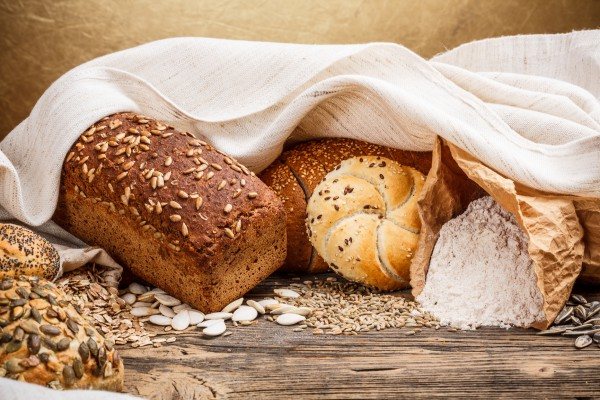
Among the many beneficial properties of rye flour is the ability to influence the renewal of body tissues at the cellular level. Raw materials strengthen blood vessels, improve peristalsis without harm to the digestive system, and have a positive effect on the immune system.
For men
Men should take advantage of the beneficial properties of rye flour. Especially middle and old age. It is a source of plant phytoestrogens, which reduce the risk of prostate cancer, and if the problem has already arisen, they help in treatment.
Dark bread will not harm people doing physical work or athletes. Useful amino acids, protein, and complex carbohydrates nourish the body for a long time, giving it energy gradually. Thus, fatigue does not set in immediately, and endurance increases.
For women
It is advisable for women to consume baked goods made from dark flour, even ordinary bread, daily. Without harm to the figure, it will be possible to prevent the occurrence or facilitate the treatment processes:
- mastopathy;
- cholelithiasis;
- hormonal imbalances;
- breast cancer
A significant amount of phytoestrogens entering the body will provide first aid during PMS, delay the onset of menopause, and make its course milder. Women are also advised not to neglect the benefits of this folk remedy by at least periodically washing their hair with rye flour.
The benefits of rye flour
Due to the presence of calcium, rye flour ensures the complete formation of the skeleton. It has a positive effect on the functioning of the nervous system. And due to potassium, it stimulates the transmission of nerve impulses throughout the body. The benefits of rye flour are due to iron and magnesium, which help normalize hematopoiesis. Eating rye flour helps strengthen bones and cartilage. This effect occurs due to the presence of fluorine, micro- and macroelements. These components can be preserved in flour even after heat treatment. Also, rye flour, the benefits of which are so high, helps speed up metabolic processes in the body. Thanks to the vitamins contained in flour, the nervous system strengthens and becomes more resilient to stress and nervous situations.
Important vitamins contained in rye are representatives of group B. Their lack in the body leads to the appearance of heart diseases. This group of components protects against myocardial infarction. Vitamins from this group protect the thyroid gland and enhance the reproductive function of the body, and folic acid helps normalize the growth of the entire body and prevents the occurrence of anemia.
Doctors advise people who rarely go out into the sun to eat dishes containing rye flour. The composition of rye flour provides the body with vitamins. Rye bread is also useful for those suffering from anemia or metabolic disorders.
Is it possible to have rye flour during pregnancy and breastfeeding?
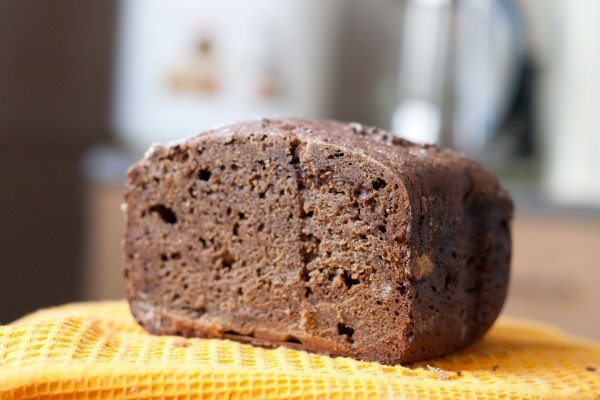
Eating white bread can be harmful, causing constipation, excess weight gain, and a feeling of heaviness in the intestines. If such problems arise, it is advisable to switch to products made from dark flour, especially Borodino bread, consuming about 3-4 slices per day. Larger amounts can cause harm by causing poor fluid removal, especially water from the uterus, thereby complicating labor.
Compliance with the daily norm will give the expectant mother energy without harm to the fetus and normalize peristalsis. After giving birth, portions of dishes using dark flour can be safely doubled, including them in the diet from the first day, after first finding out the child’s reaction to the new product.
Advice! Women after childbirth often complain about the formation of cellulite. The beneficial properties of rye products help maintain smoothness and firmness of the skin.
Harm of rye flour
It should be noted right away that when rye flour is consumed in the diet in a balanced amount, the product has no contraindications for use. If the amount of rye flour “eaten” exceeds the norm, you may encounter the following problems:
- increased acidity;
- bloating (flatulence);
Interesting: Calorie content of persimmon
- various allergic reactions on the skin;
- exacerbation of gastritis;
- decrease in physical activity (in large quantities, rye flour is poorly absorbed and takes a long time to digest, creating a feeling of heaviness and taking away from the body the energy necessary for life);
- a set of extra kilos, since the calorie content of rye flour is quite high.
Baked goods made from rye flour for children
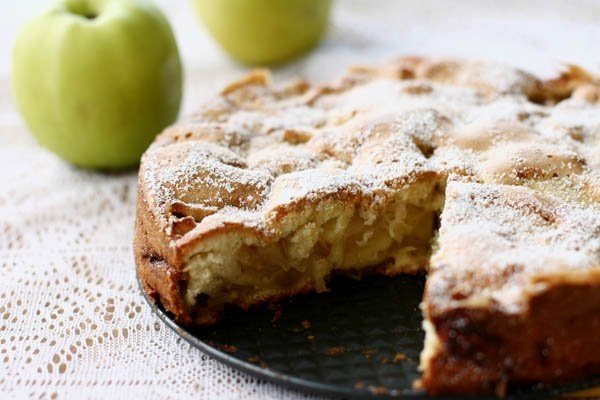
Experts have different opinions regarding the age when a child can try rye products without harm. Some insist on 3 years of age, others argue that after consultation with a pediatrician or doctor, starting from 1 year old, the baby can be periodically given about 30–40 g of baked goods.
To create it you need to use only high-quality raw materials. And also remember: freshly baked bread is definitely considered harmful due to fermentation in the stomach, especially when combined with fish, jam, and meat. If there is no other choice, a portion of bread designed for a child should become a little stale after standing for 2-3 days.
What to cook with rye flour
Since rye flour in its pure form has low elasticity and elasticity due to the lack of gluten, it is better to mix it with other types. Wheat flour is best. With the addition of rye flour, not only the benefits of the prepared dish increase, but also the shelf life. Sourdough for kvass is also prepared on the basis of rye flour. Without such flour, the drink cannot be obtained. Interestingly, in order to avoid possible harmful impurities, it is better to prepare kvass in glass containers. Rye flour absorbs odors well, absorbing them. For this reason, it should be stored separately from products with strong odors. Such measures will allow you to obtain fragrant, rye-smelling baked goods.
Is rye flour good for diabetes and cholecystitis?
Rye flour is useful for diabetes and cholecystitis, but the use of products made from it is associated with some restrictions. Considering the properties of the product, the benefits and harm that they can cause to the body, the permissible dose for patients with diabetes is limited to 300–350 g, and then only due to long-term carbohydrates.
Consumption for cholecystitis is limited to the period of remission and the daily allowance of 150 g. Bread and pastries should be slightly stale. The same norm is prescribed for patients suffering from low acidity.
Types of rye flour
It is customary to distinguish three types of rye flour, which differ in the degree of grinding, yield and content of bran particles:
- sifted rye flour;
- peeled rye flour;
- rye wallpaper flour.
Depending on the content of bran particles, the color of rye flour also differs - the fewer there are, the lighter the product. The low calorie content of rye flour, as well as a large amount of vitamins and minerals, make finished products made from it tasty and healthy. Regardless of the type of rye flour, its main purpose is to bake table breads.
Medicinal products based on rye flour
Raw rye is recognized not only as a food product, it is a natural medicine that helps in the treatment of the most common diseases.

For high blood pressure
The most effective remedy to help people at stages 2 and 3 of hypertension is to consume on an empty stomach a spoonful of coarse rye flour, previously filled with hot water. If you have permission from your attending physician, the beneficial properties of the product can be enhanced by taking laxatives at the same time.
For chronic colds
The substance is useful for chronic runny nose. Treatment with rye flour cakes will help get rid of an unpleasant illness:
- take some flour, grated horseradish and honey;
- mix thoroughly to make an elastic dough;
- roll out the flatbread to medium thickness;
- place on the bridge of the nose and hold for 15–20 minutes.
Repeat the procedure daily for 7–10 days, always mixing a fresh portion.
Important! During this time, the illness should go away; if not, a second visit to the doctor is necessary.
Compress for lymphostasis
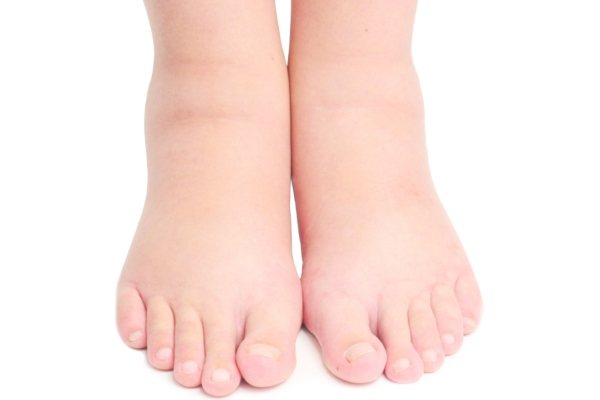
Problems with the outflow of fluids in the legs cause a lot of inconvenience and discomfort. A special compress will help improve the situation, for the preparation of which you need to prepare 250–300 g of rye raw material, brewed with boiling water.
- The mass is mixed and left to cool completely.
- Then kefir is added to the compress, everything is again brought to a homogeneous state.
- The mixture is spread on a napkin of natural fabric or bandage, which is placed on the swollen area and wrapped with waterproof film.
- The procedures are carried out daily in the morning and evening until the swelling disappears. The holding time of one compress is about 2 hours.
Compress for radiculitis
The properties of rye help get rid of radiculitis or, in difficult cases, alleviate symptoms.
To prepare the compress you need to take:
- 2.5 liters of heated water;
- a spoonful of sugar;
- 10 g yeast;
- 500 g flour.
Preparation:
- The ingredients are poured into a hermetically sealed container, shaken well and infused for 5 days.
- Before use, a cloth is soaked in the mixture and placed on the sore spot.
- The compress is kept for 30 minutes, after removing it you need to lie down for the same amount of time.
- The procedure is repeated once a day for 10 days.
Calculation of caloric content of a product per 100 grams
The calculation of the calorie content of 100 grams of product is based on previously known indicators of BZHU (abbreviation: proteins-fats-carbohydrates). The calculation method is the summation of these data (obtained by laboratory analysis and calculations) previously multiplied by a value equal to the energy released (calories) during their splitting. So, for example, 1 gram of protein or carbohydrate can release energy equal to 4.1 kcal, and fat a little more than 9. In calorie calculations, these numbers are usually rounded to whole numbers, as is the result itself.
Our example involves proteins - 8.9 grams, fats - 1.7 grams and carbohydrates - 61.8 grams contained in 100 grams of product. Next we perform the calculation:
Energy value of 100 grams = 8.9 (proteins)*4 + 1.7 (fat)*9 + 61.8 (carbohydrates)*4 = 35.6 + 15.3 + 247.2 = 298.1 kcal
Our calculated calorie content is more than 250 kcal, which means that whole rye flour is a high-calorie product with a high protein content, carbohydrates and an average level of fat.
Rye flour in home cosmetology
The substance is a recognized cosmetic aid that can improve the condition of hair and facial skin in a short time. Using the valuable properties of the product, the benefits and lack of harm in this area, masks, shampoos, and compresses are created from it.
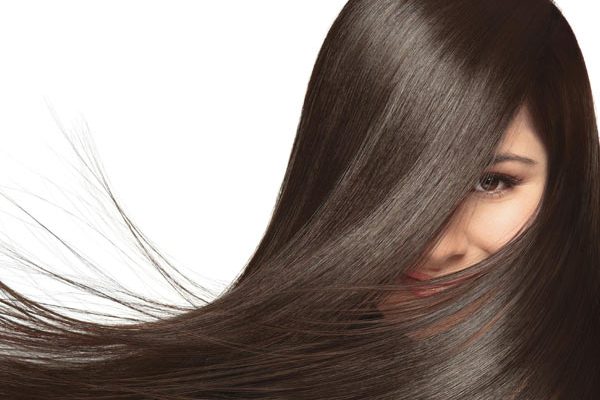
Face masks
A harmful external environment, frequent stress, and poor quality nutrition inevitably affect the condition of facial skin. Age-related changes do not add beauty, which are becoming increasingly difficult to combat. The help of rye raw materials on this front is difficult to overestimate, since the benefits of its use are enormous.
Thanks to him he manages to:
- gently cleanse pores;
- tone the skin;
- achieve harmless whitening;
- relieve irritation.
Rye flour has regenerating properties, neutralizes inflammatory processes, removes age spots, smooths out small wrinkles, and evens out color.
The simplest option is to mix flour and water or milk until creamy and apply it to a cleansed face. A mask made from a mixture of rye flour, chamomile essential oil, primrose, vitamin A and a drop of honey is also universal.
To nourish the epidermis, you need to mix the main product with sour cream, and a mixture of aloe juice and milk will help relieve inflammation.
If there is a need for pre-peeling, rye flour can be mixed with a small amount of boiled ground coffee and cherry juice.
Advice! Even in advanced cases, it is advisable to keep the mask on for no more than 15–20 minutes. It is not advisable to repeat the procedure more than 2-3 times a week. Too frequent cosmetic procedures cause just as much harm as not having enough of them.
Shampoos made from rye flour for washing hair
Systematic use of rye flour shampoo allows you to:
- normalize the secretions of the sebaceous glands;
- effectively combat hair loss;
- quickly get rid of dandruff;
- make hair more manageable.
Homemade shampoo for oily hair consists of the following ingredients:
- a little essential oil;
- 100 ml milk;
- 50 g rye flour.
The mixture is applied 2 times, then completely washed off without the use of chemicals. Blondes whose hair shade is slightly yellow should add a little lemon juice and honey to the main mixture.
Important! Rye flour is also used instead of dry shampoo if it is not possible to wash your hair properly. The product is rubbed in and then combed out.
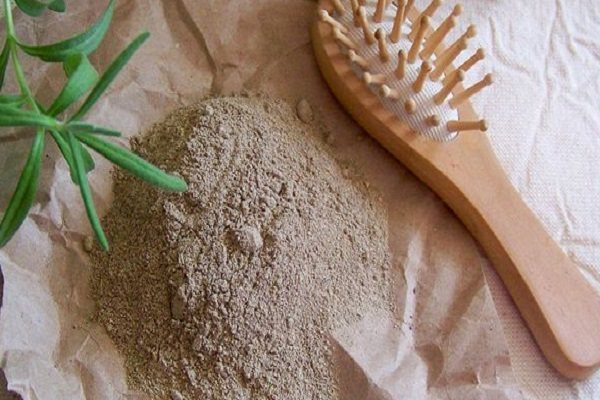
Mask for brittle and thin hair
The positive nutritional properties of rye flour are perfectly complemented by egg yolk, which contains at least 200 useful substances. The prepared mask will strengthen hair follicles, stop hair loss, and stimulate growth. If there is no negative reaction to alcohol-containing masks, add a spoonful of cognac to the mixture.
A hair mask made from rye flour is applied to dirty hair and rubbed into the scalp. After 10–20 minutes. it can be washed off. It is normal if after the first use a little dandruff appears, this is how the skin is cleansed of dead cells and chemical residues. The use of a folk remedy without causing harm is limited to 1–2 procedures per 10 days.
Seeded rye flour: nutritional value, BZHU, vitamins and chemical composition
Read more about microelements in the composition of rye flour.
Iron, Fe
- is involved in the formation of hemoglobin. Without the help of iron, the formation of muscle pigment - myoglobin - is impossible. Without it, the formation of the human immune system is impossible. Takes part in the synthesis of thyroid hormones. The presence of iron in the body is a prerequisite for the absorption of B vitamins. It delivers oxygen to the cells.
Manganese, Mn
— a chemical element is necessary for the human body, but in small quantities. Participates in the processes of blood clotting and bone tissue formation. It has an anti-inflammatory effect, participates in the metabolism of amino acids, cholesterol, glucose and carbohydrates. The human body cannot synthesize manganese on its own, but it receives it from food in sufficient quantities.
Copper, Cu
- Contained in almost all internal organs, ensuring their normal functioning.
Participates in the production of hemoglobin and provides cells with a supply of oxygen. It has a powerful anti-inflammatory effect, protects the body from external attacks - viruses and bacteria. Directly participates in collagen synthesis, ensuring skin elasticity and radiance. Affects the synthesis of the pituitary gland, regulates the functioning of the endocrine system. Powerful antioxidant. show all
Zinc, Zn
- the metal is present in all cells of the body and is necessary for cell division. A powerful oxidant that can provide protection against the proliferation of cancer cells. Maintains hormonal balance in the body, helps fight diabetes. It has a positive effect on the elasticity of blood vessels and reduces inflammation. Combats digestive problems.
Aluminium, Al
- the most important immunotoxin microelement. The highly active element is capable of creating compounds with most chemicals. It stimulates cell regeneration processes, participates in the formation of cells of bones, ligaments, cartilage and muscle tissue. Promotes epithelization of the skin. Increases the efficiency of digestive enzymes and activates the thyroid gland. Catalyzes the production of phosphate and protein complexes.
Molybdenum, Mo
- an important, but dangerous mineral for the body. Activates enzymes that break down sulfites and remove dangerous toxins from the human body.
Breaks down aldehydes that can poison the body - breaks down alcohol and some medications, protecting the liver. Converts xanthine to uric acid. collapse
Which is healthier: rye or wheat flour?

In terms of its properties, composition and benefits for the body, rye flour is significantly ahead of its wheat counterpart. The rye product has a low glycemic index, contains a large amount of enzymes that break down starch compounds, and also produces a small amount of gluten, minimizing harm to health.
It is worth emphasizing that during kneading the dough, only sourdough is used, and not traditional yeast, this makes the product healthy and allows you to include it in the diet.
